Comprehensive Analysis of Management Communication Strategies
VerifiedAdded on 2023/06/04
|39
|6388
|455
Report
AI Summary
This report comprehensively examines key aspects of management communication. It begins by exploring personal and interpersonal communication, including communication channels, personal network development, and the role of the grapevine. The report then delves into crisis communication, defining crises, outlining objectives, and discussing various theories and models, such as the Image Restoration Theory and Situational Crisis Communication Theory. It also provides tactics and strategies for effective crisis management. Finally, the report analyzes the aspects of communication related to sustainability, covering the concept of sustainability, communication of sustainable activities, carbon footprint communications, and corporate social responsibility (CSR), including types of CSR, its importance, and relevant theories like the Stakeholder Theory and Profit Maximization Theory. The report provides a complete overview of how communication is crucial for effective management and organizational success, especially during crises and in promoting sustainability.
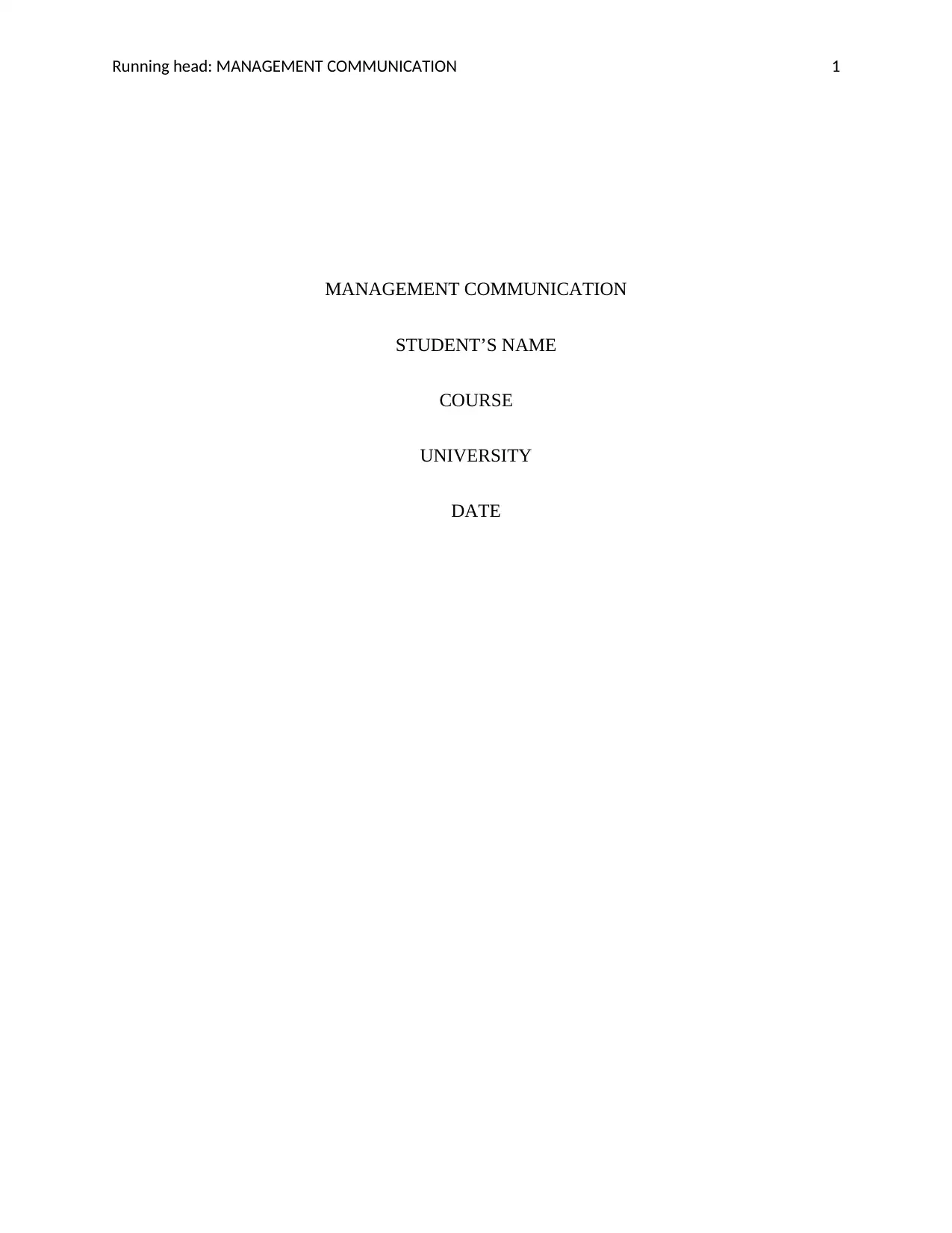
Running head: MANAGEMENT COMMUNICATION 1
MANAGEMENT COMMUNICATION
STUDENT’S NAME
COURSE
UNIVERSITY
DATE
MANAGEMENT COMMUNICATION
STUDENT’S NAME
COURSE
UNIVERSITY
DATE
Paraphrase This Document
Need a fresh take? Get an instant paraphrase of this document with our AI Paraphraser
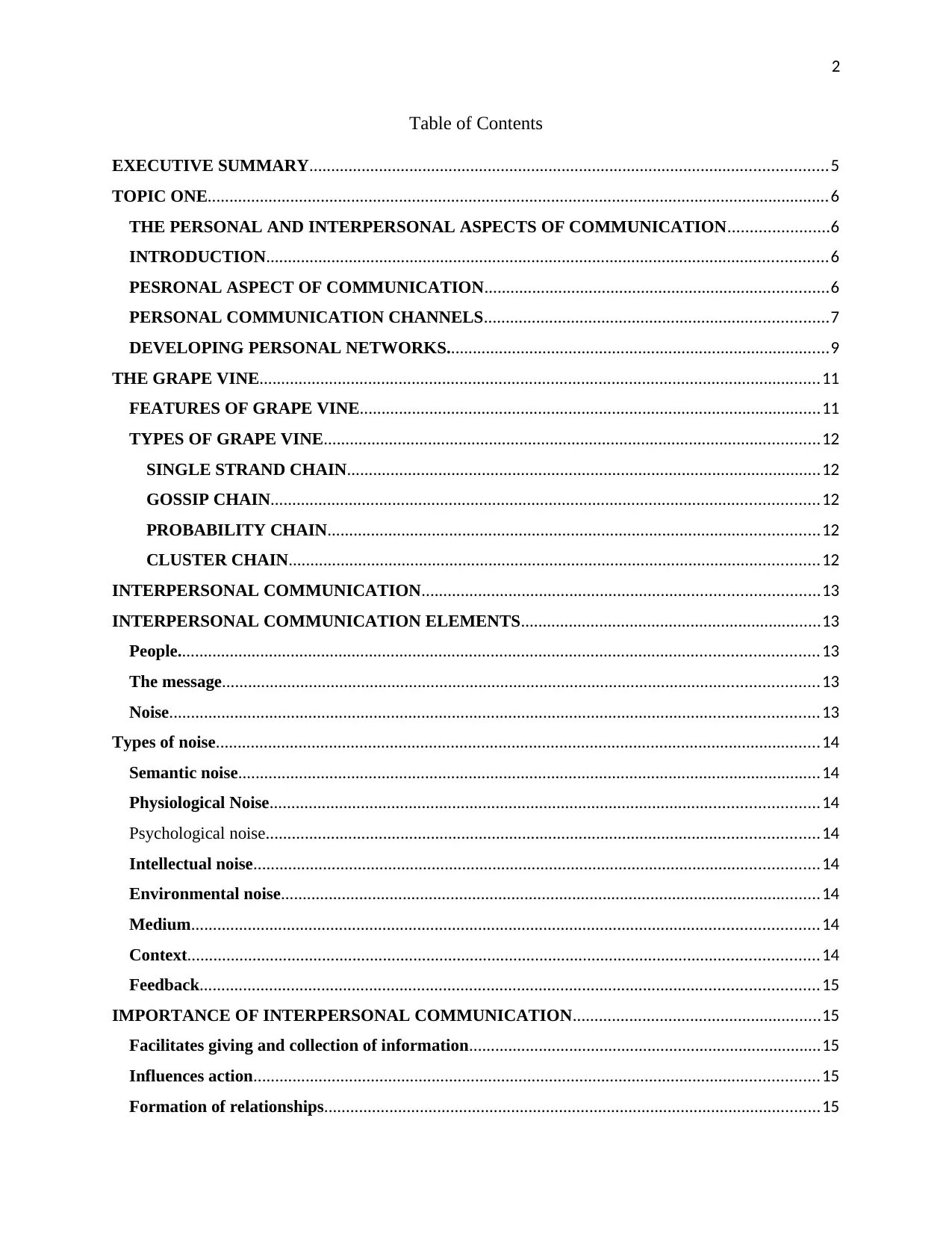
2
Table of Contents
EXECUTIVE SUMMARY.......................................................................................................................5
TOPIC ONE...............................................................................................................................................6
THE PERSONAL AND INTERPERSONAL ASPECTS OF COMMUNICATION.......................6
INTRODUCTION.................................................................................................................................6
PESRONAL ASPECT OF COMMUNICATION...............................................................................6
PERSONAL COMMUNICATION CHANNELS...............................................................................7
DEVELOPING PERSONAL NETWORKS........................................................................................9
THE GRAPE VINE.................................................................................................................................11
FEATURES OF GRAPE VINE..........................................................................................................11
TYPES OF GRAPE VINE..................................................................................................................12
SINGLE STRAND CHAIN.............................................................................................................12
GOSSIP CHAIN..............................................................................................................................12
PROBABILITY CHAIN.................................................................................................................12
CLUSTER CHAIN..........................................................................................................................12
INTERPERSONAL COMMUNICATION...........................................................................................13
INTERPERSONAL COMMUNICATION ELEMENTS.....................................................................13
People...................................................................................................................................................13
The message.........................................................................................................................................13
Noise.....................................................................................................................................................13
Types of noise...........................................................................................................................................14
Semantic noise......................................................................................................................................14
Physiological Noise..............................................................................................................................14
Psychological noise...............................................................................................................................14
Intellectual noise..................................................................................................................................14
Environmental noise............................................................................................................................14
Medium................................................................................................................................................14
Context.................................................................................................................................................14
Feedback..............................................................................................................................................15
IMPORTANCE OF INTERPERSONAL COMMUNICATION.........................................................15
Facilitates giving and collection of information.................................................................................15
Influences action..................................................................................................................................15
Formation of relationships..................................................................................................................15
Table of Contents
EXECUTIVE SUMMARY.......................................................................................................................5
TOPIC ONE...............................................................................................................................................6
THE PERSONAL AND INTERPERSONAL ASPECTS OF COMMUNICATION.......................6
INTRODUCTION.................................................................................................................................6
PESRONAL ASPECT OF COMMUNICATION...............................................................................6
PERSONAL COMMUNICATION CHANNELS...............................................................................7
DEVELOPING PERSONAL NETWORKS........................................................................................9
THE GRAPE VINE.................................................................................................................................11
FEATURES OF GRAPE VINE..........................................................................................................11
TYPES OF GRAPE VINE..................................................................................................................12
SINGLE STRAND CHAIN.............................................................................................................12
GOSSIP CHAIN..............................................................................................................................12
PROBABILITY CHAIN.................................................................................................................12
CLUSTER CHAIN..........................................................................................................................12
INTERPERSONAL COMMUNICATION...........................................................................................13
INTERPERSONAL COMMUNICATION ELEMENTS.....................................................................13
People...................................................................................................................................................13
The message.........................................................................................................................................13
Noise.....................................................................................................................................................13
Types of noise...........................................................................................................................................14
Semantic noise......................................................................................................................................14
Physiological Noise..............................................................................................................................14
Psychological noise...............................................................................................................................14
Intellectual noise..................................................................................................................................14
Environmental noise............................................................................................................................14
Medium................................................................................................................................................14
Context.................................................................................................................................................14
Feedback..............................................................................................................................................15
IMPORTANCE OF INTERPERSONAL COMMUNICATION.........................................................15
Facilitates giving and collection of information.................................................................................15
Influences action..................................................................................................................................15
Formation of relationships..................................................................................................................15
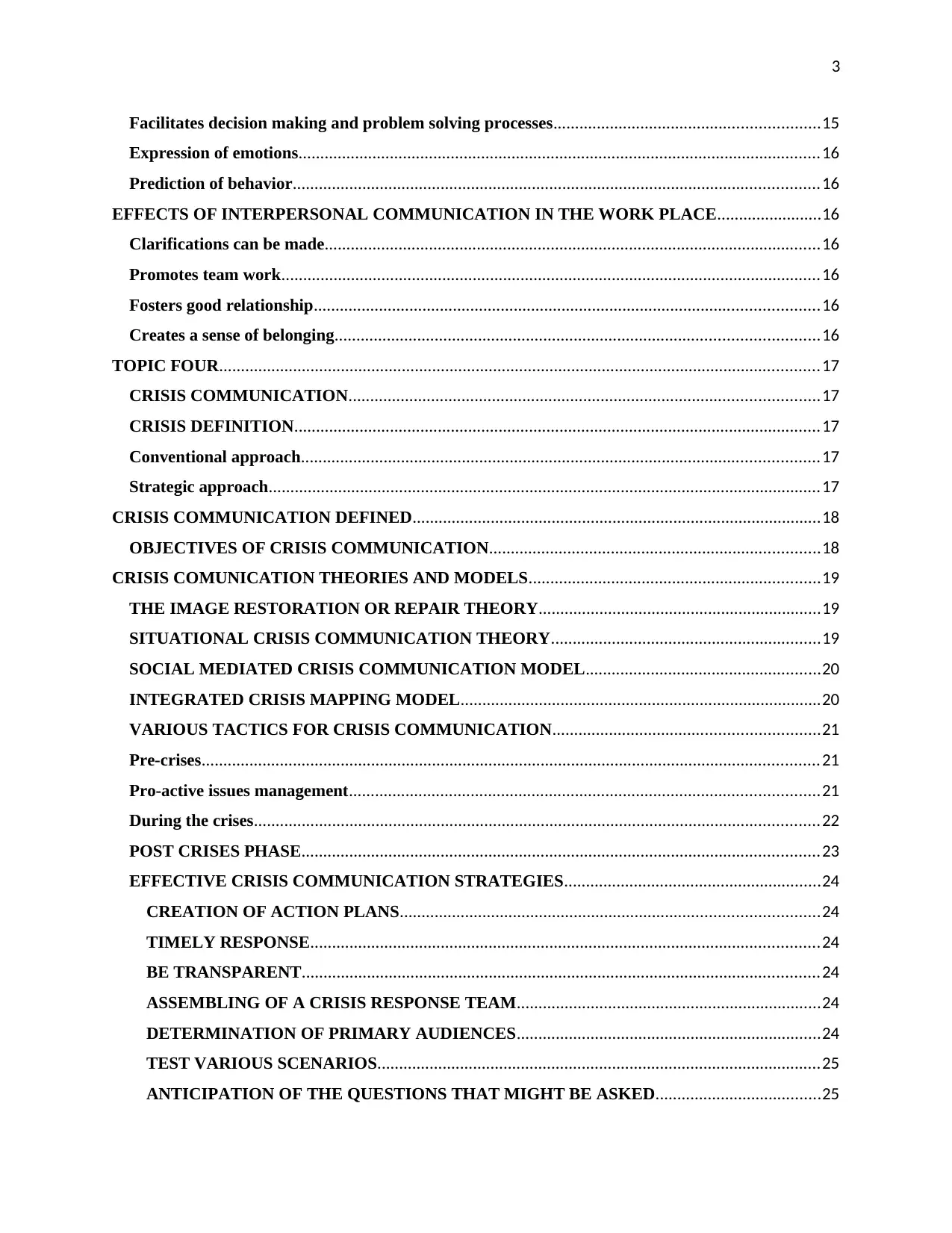
3
Facilitates decision making and problem solving processes.............................................................15
Expression of emotions........................................................................................................................16
Prediction of behavior.........................................................................................................................16
EFFECTS OF INTERPERSONAL COMMUNICATION IN THE WORK PLACE........................16
Clarifications can be made..................................................................................................................16
Promotes team work............................................................................................................................16
Fosters good relationship....................................................................................................................16
Creates a sense of belonging...............................................................................................................16
TOPIC FOUR..........................................................................................................................................17
CRISIS COMMUNICATION............................................................................................................17
CRISIS DEFINITION.........................................................................................................................17
Conventional approach.......................................................................................................................17
Strategic approach...............................................................................................................................17
CRISIS COMMUNICATION DEFINED..............................................................................................18
OBJECTIVES OF CRISIS COMMUNICATION............................................................................18
CRISIS COMUNICATION THEORIES AND MODELS...................................................................19
THE IMAGE RESTORATION OR REPAIR THEORY.................................................................19
SITUATIONAL CRISIS COMMUNICATION THEORY..............................................................19
SOCIAL MEDIATED CRISIS COMMUNICATION MODEL......................................................20
INTEGRATED CRISIS MAPPING MODEL...................................................................................20
VARIOUS TACTICS FOR CRISIS COMMUNICATION.............................................................21
Pre-crises..............................................................................................................................................21
Pro-active issues management............................................................................................................21
During the crises..................................................................................................................................22
POST CRISES PHASE.......................................................................................................................23
EFFECTIVE CRISIS COMMUNICATION STRATEGIES...........................................................24
CREATION OF ACTION PLANS................................................................................................24
TIMELY RESPONSE.....................................................................................................................24
BE TRANSPARENT.......................................................................................................................24
ASSEMBLING OF A CRISIS RESPONSE TEAM......................................................................24
DETERMINATION OF PRIMARY AUDIENCES......................................................................24
TEST VARIOUS SCENARIOS......................................................................................................25
ANTICIPATION OF THE QUESTIONS THAT MIGHT BE ASKED......................................25
Facilitates decision making and problem solving processes.............................................................15
Expression of emotions........................................................................................................................16
Prediction of behavior.........................................................................................................................16
EFFECTS OF INTERPERSONAL COMMUNICATION IN THE WORK PLACE........................16
Clarifications can be made..................................................................................................................16
Promotes team work............................................................................................................................16
Fosters good relationship....................................................................................................................16
Creates a sense of belonging...............................................................................................................16
TOPIC FOUR..........................................................................................................................................17
CRISIS COMMUNICATION............................................................................................................17
CRISIS DEFINITION.........................................................................................................................17
Conventional approach.......................................................................................................................17
Strategic approach...............................................................................................................................17
CRISIS COMMUNICATION DEFINED..............................................................................................18
OBJECTIVES OF CRISIS COMMUNICATION............................................................................18
CRISIS COMUNICATION THEORIES AND MODELS...................................................................19
THE IMAGE RESTORATION OR REPAIR THEORY.................................................................19
SITUATIONAL CRISIS COMMUNICATION THEORY..............................................................19
SOCIAL MEDIATED CRISIS COMMUNICATION MODEL......................................................20
INTEGRATED CRISIS MAPPING MODEL...................................................................................20
VARIOUS TACTICS FOR CRISIS COMMUNICATION.............................................................21
Pre-crises..............................................................................................................................................21
Pro-active issues management............................................................................................................21
During the crises..................................................................................................................................22
POST CRISES PHASE.......................................................................................................................23
EFFECTIVE CRISIS COMMUNICATION STRATEGIES...........................................................24
CREATION OF ACTION PLANS................................................................................................24
TIMELY RESPONSE.....................................................................................................................24
BE TRANSPARENT.......................................................................................................................24
ASSEMBLING OF A CRISIS RESPONSE TEAM......................................................................24
DETERMINATION OF PRIMARY AUDIENCES......................................................................24
TEST VARIOUS SCENARIOS......................................................................................................25
ANTICIPATION OF THE QUESTIONS THAT MIGHT BE ASKED......................................25
⊘ This is a preview!⊘
Do you want full access?
Subscribe today to unlock all pages.

Trusted by 1+ million students worldwide
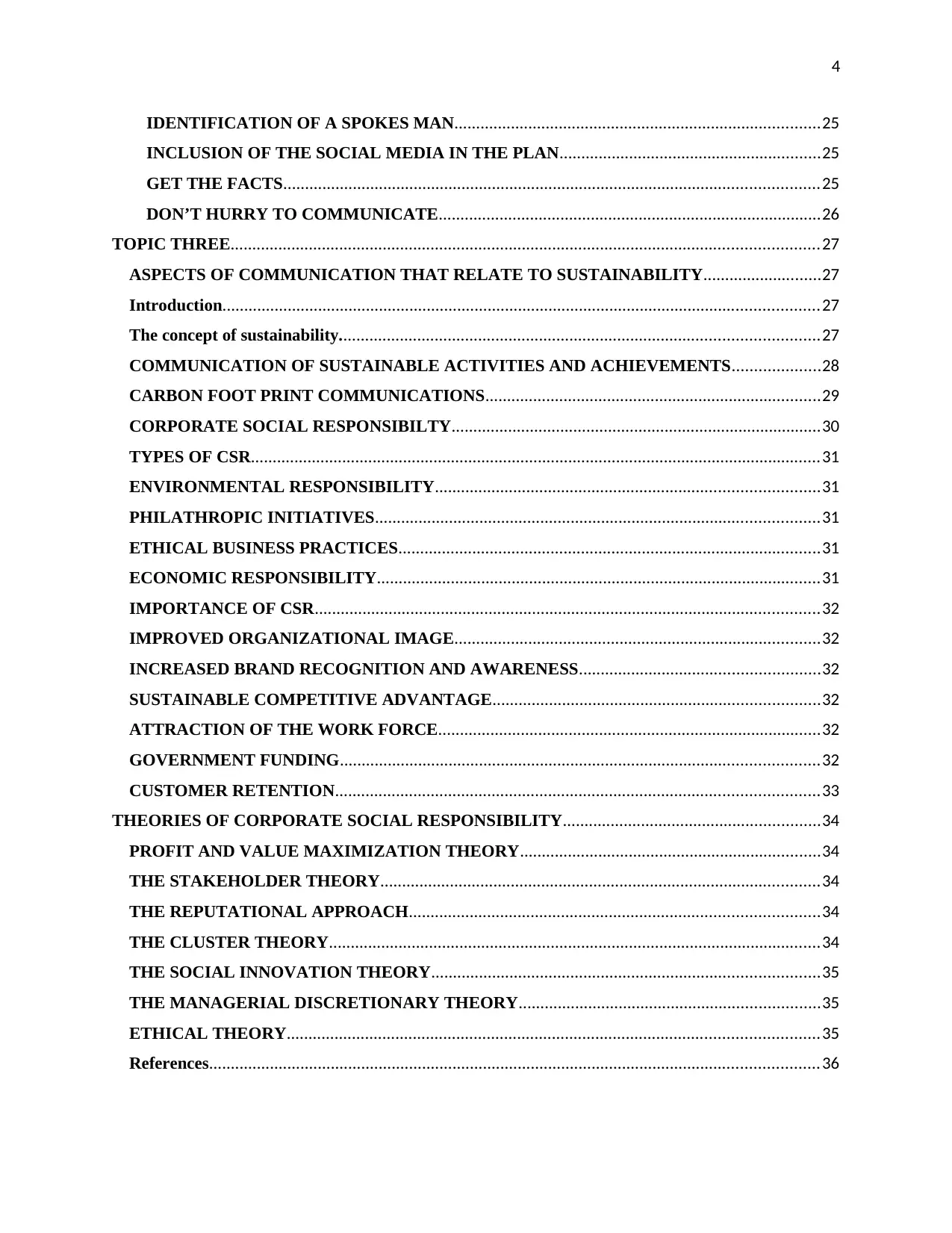
4
IDENTIFICATION OF A SPOKES MAN....................................................................................25
INCLUSION OF THE SOCIAL MEDIA IN THE PLAN............................................................25
GET THE FACTS...........................................................................................................................25
DON’T HURRY TO COMMUNICATE........................................................................................26
TOPIC THREE.......................................................................................................................................27
ASPECTS OF COMMUNICATION THAT RELATE TO SUSTAINABILITY...........................27
Introduction.........................................................................................................................................27
The concept of sustainability..............................................................................................................27
COMMUNICATION OF SUSTAINABLE ACTIVITIES AND ACHIEVEMENTS....................28
CARBON FOOT PRINT COMMUNICATIONS.............................................................................29
CORPORATE SOCIAL RESPONSIBILTY.....................................................................................30
TYPES OF CSR...................................................................................................................................31
ENVIRONMENTAL RESPONSIBILITY........................................................................................31
PHILATHROPIC INITIATIVES......................................................................................................31
ETHICAL BUSINESS PRACTICES.................................................................................................31
ECONOMIC RESPONSIBILITY......................................................................................................31
IMPORTANCE OF CSR....................................................................................................................32
IMPROVED ORGANIZATIONAL IMAGE....................................................................................32
INCREASED BRAND RECOGNITION AND AWARENESS.......................................................32
SUSTAINABLE COMPETITIVE ADVANTAGE...........................................................................32
ATTRACTION OF THE WORK FORCE........................................................................................32
GOVERNMENT FUNDING..............................................................................................................32
CUSTOMER RETENTION...............................................................................................................33
THEORIES OF CORPORATE SOCIAL RESPONSIBILITY...........................................................34
PROFIT AND VALUE MAXIMIZATION THEORY.....................................................................34
THE STAKEHOLDER THEORY.....................................................................................................34
THE REPUTATIONAL APPROACH..............................................................................................34
THE CLUSTER THEORY.................................................................................................................34
THE SOCIAL INNOVATION THEORY.........................................................................................35
THE MANAGERIAL DISCRETIONARY THEORY.....................................................................35
ETHICAL THEORY..........................................................................................................................35
References............................................................................................................................................36
IDENTIFICATION OF A SPOKES MAN....................................................................................25
INCLUSION OF THE SOCIAL MEDIA IN THE PLAN............................................................25
GET THE FACTS...........................................................................................................................25
DON’T HURRY TO COMMUNICATE........................................................................................26
TOPIC THREE.......................................................................................................................................27
ASPECTS OF COMMUNICATION THAT RELATE TO SUSTAINABILITY...........................27
Introduction.........................................................................................................................................27
The concept of sustainability..............................................................................................................27
COMMUNICATION OF SUSTAINABLE ACTIVITIES AND ACHIEVEMENTS....................28
CARBON FOOT PRINT COMMUNICATIONS.............................................................................29
CORPORATE SOCIAL RESPONSIBILTY.....................................................................................30
TYPES OF CSR...................................................................................................................................31
ENVIRONMENTAL RESPONSIBILITY........................................................................................31
PHILATHROPIC INITIATIVES......................................................................................................31
ETHICAL BUSINESS PRACTICES.................................................................................................31
ECONOMIC RESPONSIBILITY......................................................................................................31
IMPORTANCE OF CSR....................................................................................................................32
IMPROVED ORGANIZATIONAL IMAGE....................................................................................32
INCREASED BRAND RECOGNITION AND AWARENESS.......................................................32
SUSTAINABLE COMPETITIVE ADVANTAGE...........................................................................32
ATTRACTION OF THE WORK FORCE........................................................................................32
GOVERNMENT FUNDING..............................................................................................................32
CUSTOMER RETENTION...............................................................................................................33
THEORIES OF CORPORATE SOCIAL RESPONSIBILITY...........................................................34
PROFIT AND VALUE MAXIMIZATION THEORY.....................................................................34
THE STAKEHOLDER THEORY.....................................................................................................34
THE REPUTATIONAL APPROACH..............................................................................................34
THE CLUSTER THEORY.................................................................................................................34
THE SOCIAL INNOVATION THEORY.........................................................................................35
THE MANAGERIAL DISCRETIONARY THEORY.....................................................................35
ETHICAL THEORY..........................................................................................................................35
References............................................................................................................................................36
Paraphrase This Document
Need a fresh take? Get an instant paraphrase of this document with our AI Paraphraser
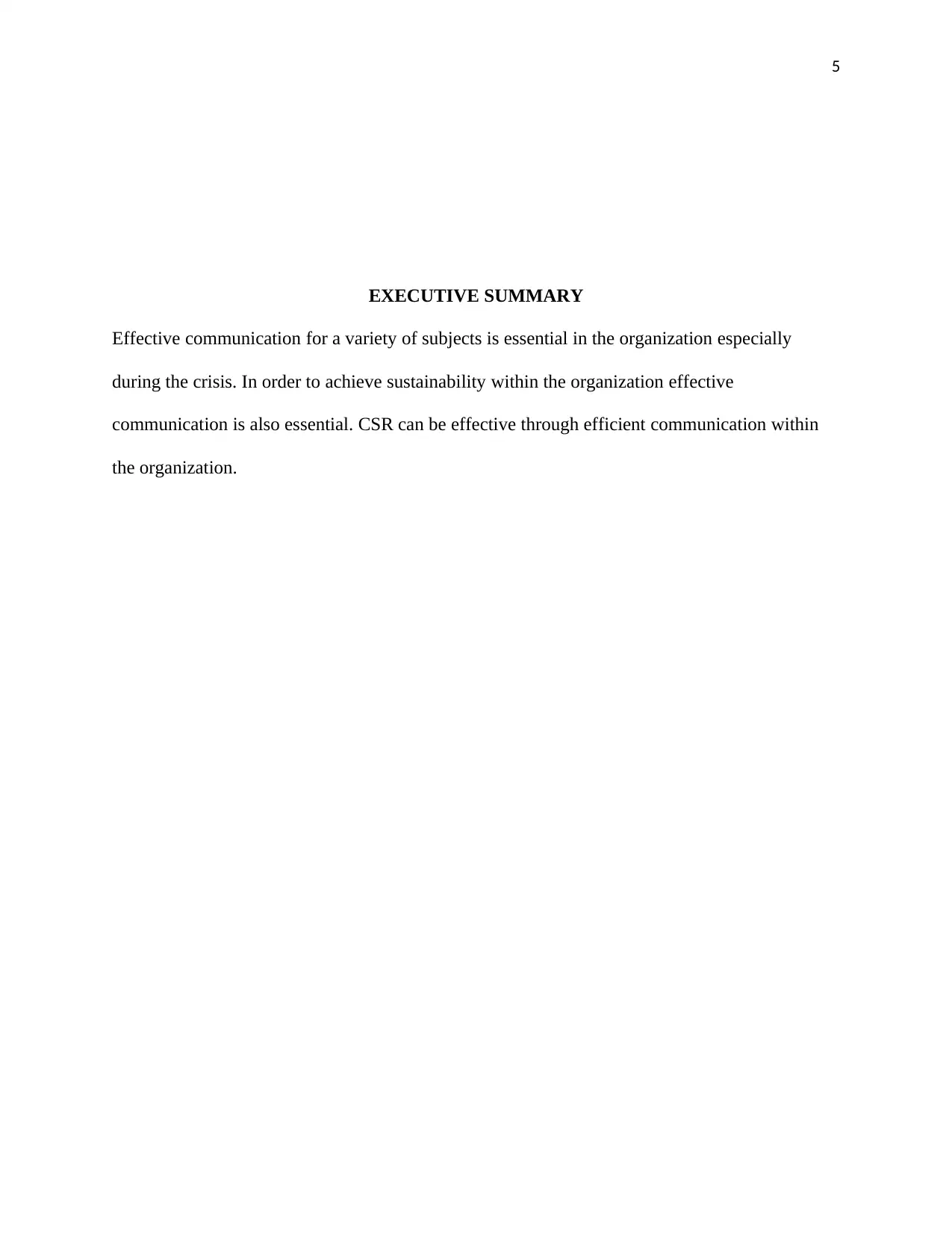
5
EXECUTIVE SUMMARY
Effective communication for a variety of subjects is essential in the organization especially
during the crisis. In order to achieve sustainability within the organization effective
communication is also essential. CSR can be effective through efficient communication within
the organization.
EXECUTIVE SUMMARY
Effective communication for a variety of subjects is essential in the organization especially
during the crisis. In order to achieve sustainability within the organization effective
communication is also essential. CSR can be effective through efficient communication within
the organization.
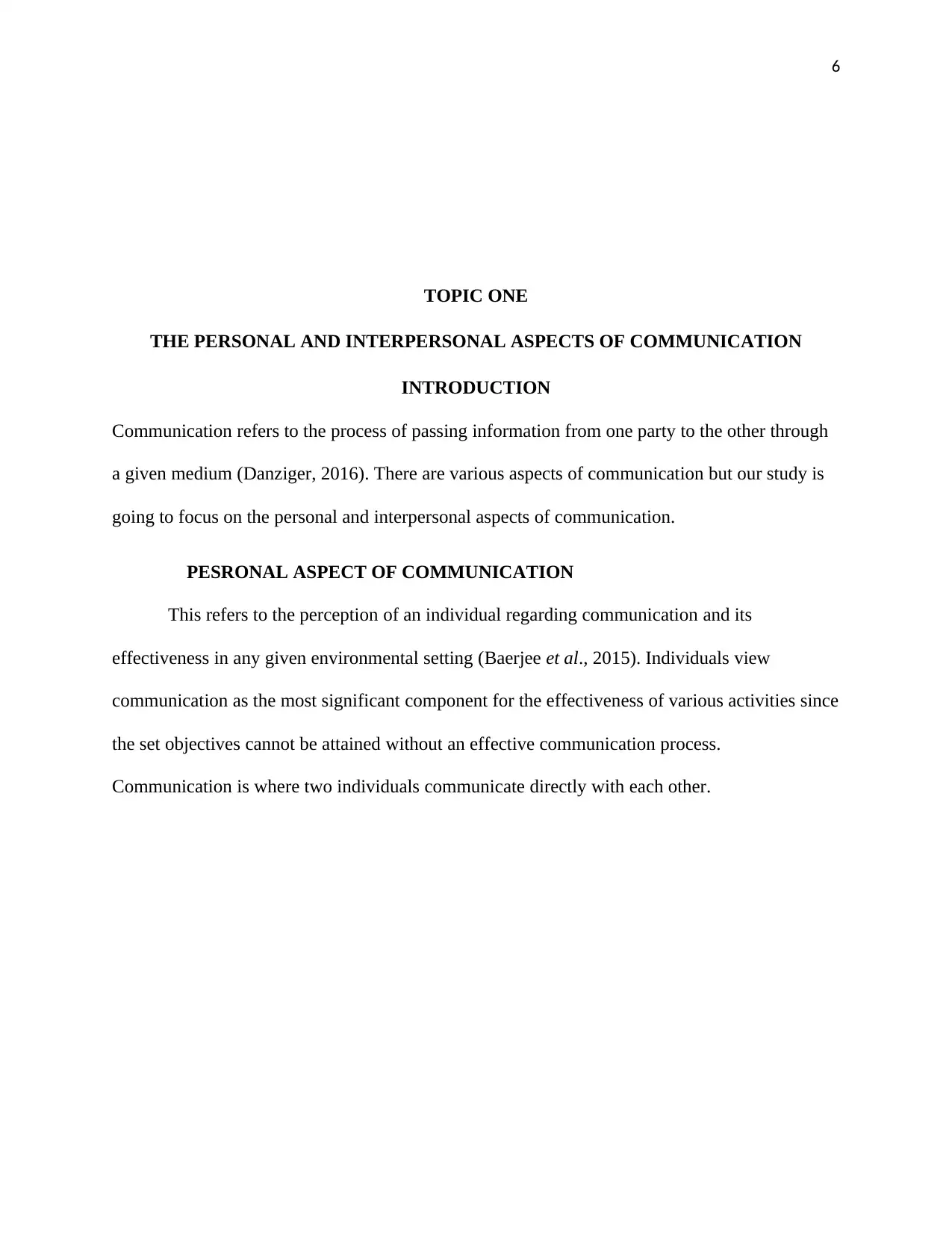
6
TOPIC ONE
THE PERSONAL AND INTERPERSONAL ASPECTS OF COMMUNICATION
INTRODUCTION
Communication refers to the process of passing information from one party to the other through
a given medium (Danziger, 2016). There are various aspects of communication but our study is
going to focus on the personal and interpersonal aspects of communication.
PESRONAL ASPECT OF COMMUNICATION
This refers to the perception of an individual regarding communication and its
effectiveness in any given environmental setting (Baerjee et al., 2015). Individuals view
communication as the most significant component for the effectiveness of various activities since
the set objectives cannot be attained without an effective communication process.
Communication is where two individuals communicate directly with each other.
TOPIC ONE
THE PERSONAL AND INTERPERSONAL ASPECTS OF COMMUNICATION
INTRODUCTION
Communication refers to the process of passing information from one party to the other through
a given medium (Danziger, 2016). There are various aspects of communication but our study is
going to focus on the personal and interpersonal aspects of communication.
PESRONAL ASPECT OF COMMUNICATION
This refers to the perception of an individual regarding communication and its
effectiveness in any given environmental setting (Baerjee et al., 2015). Individuals view
communication as the most significant component for the effectiveness of various activities since
the set objectives cannot be attained without an effective communication process.
Communication is where two individuals communicate directly with each other.
⊘ This is a preview!⊘
Do you want full access?
Subscribe today to unlock all pages.

Trusted by 1+ million students worldwide
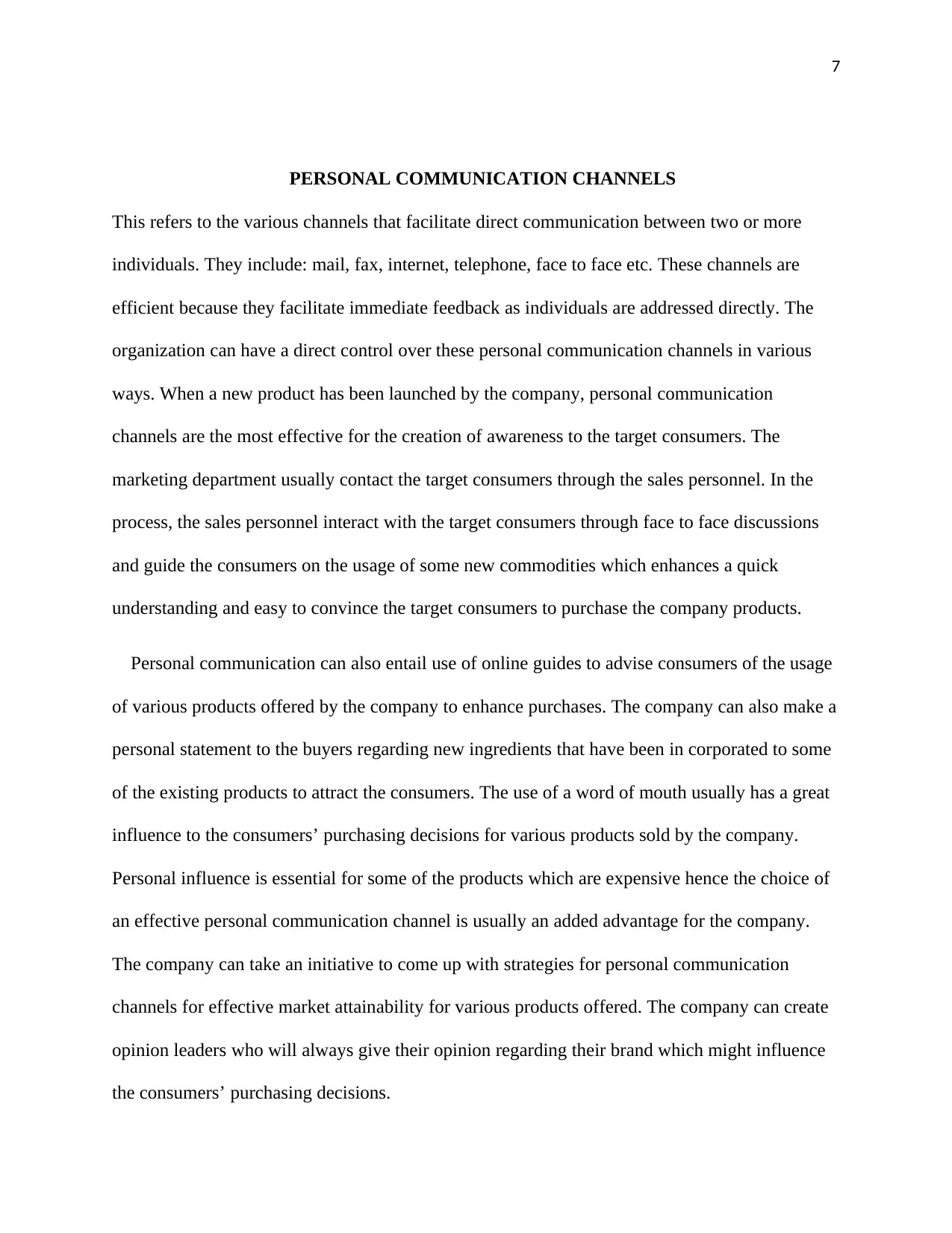
7
PERSONAL COMMUNICATION CHANNELS
This refers to the various channels that facilitate direct communication between two or more
individuals. They include: mail, fax, internet, telephone, face to face etc. These channels are
efficient because they facilitate immediate feedback as individuals are addressed directly. The
organization can have a direct control over these personal communication channels in various
ways. When a new product has been launched by the company, personal communication
channels are the most effective for the creation of awareness to the target consumers. The
marketing department usually contact the target consumers through the sales personnel. In the
process, the sales personnel interact with the target consumers through face to face discussions
and guide the consumers on the usage of some new commodities which enhances a quick
understanding and easy to convince the target consumers to purchase the company products.
Personal communication can also entail use of online guides to advise consumers of the usage
of various products offered by the company to enhance purchases. The company can also make a
personal statement to the buyers regarding new ingredients that have been in corporated to some
of the existing products to attract the consumers. The use of a word of mouth usually has a great
influence to the consumers’ purchasing decisions for various products sold by the company.
Personal influence is essential for some of the products which are expensive hence the choice of
an effective personal communication channel is usually an added advantage for the company.
The company can take an initiative to come up with strategies for personal communication
channels for effective market attainability for various products offered. The company can create
opinion leaders who will always give their opinion regarding their brand which might influence
the consumers’ purchasing decisions.
PERSONAL COMMUNICATION CHANNELS
This refers to the various channels that facilitate direct communication between two or more
individuals. They include: mail, fax, internet, telephone, face to face etc. These channels are
efficient because they facilitate immediate feedback as individuals are addressed directly. The
organization can have a direct control over these personal communication channels in various
ways. When a new product has been launched by the company, personal communication
channels are the most effective for the creation of awareness to the target consumers. The
marketing department usually contact the target consumers through the sales personnel. In the
process, the sales personnel interact with the target consumers through face to face discussions
and guide the consumers on the usage of some new commodities which enhances a quick
understanding and easy to convince the target consumers to purchase the company products.
Personal communication can also entail use of online guides to advise consumers of the usage
of various products offered by the company to enhance purchases. The company can also make a
personal statement to the buyers regarding new ingredients that have been in corporated to some
of the existing products to attract the consumers. The use of a word of mouth usually has a great
influence to the consumers’ purchasing decisions for various products sold by the company.
Personal influence is essential for some of the products which are expensive hence the choice of
an effective personal communication channel is usually an added advantage for the company.
The company can take an initiative to come up with strategies for personal communication
channels for effective market attainability for various products offered. The company can create
opinion leaders who will always give their opinion regarding their brand which might influence
the consumers’ purchasing decisions.
Paraphrase This Document
Need a fresh take? Get an instant paraphrase of this document with our AI Paraphraser

8
The companies that make an effective use of personal communicational channels enjoy a
wide market share and a sustainable competitive advantage over other firms in the industry.
The companies that make an effective use of personal communicational channels enjoy a
wide market share and a sustainable competitive advantage over other firms in the industry.
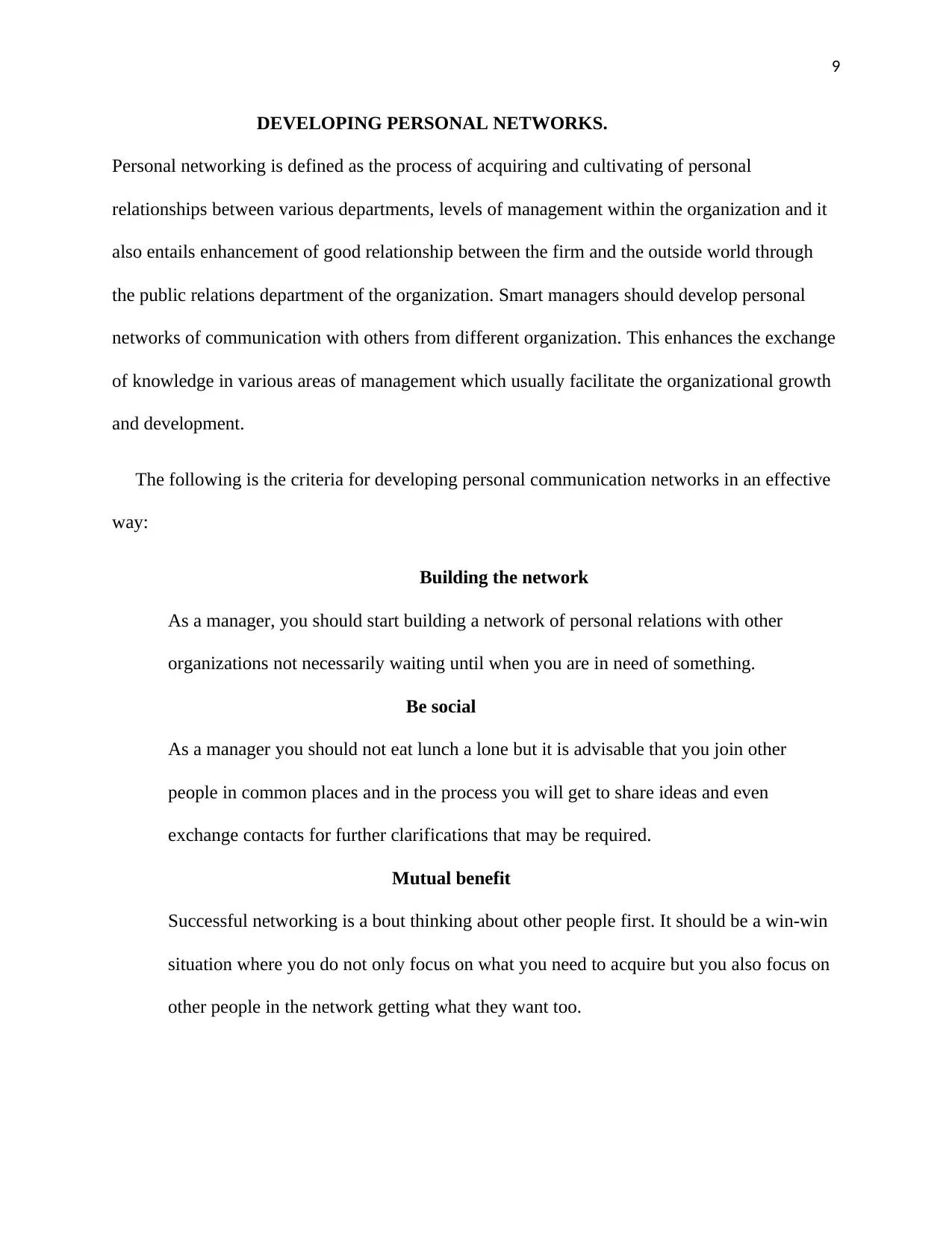
9
DEVELOPING PERSONAL NETWORKS.
Personal networking is defined as the process of acquiring and cultivating of personal
relationships between various departments, levels of management within the organization and it
also entails enhancement of good relationship between the firm and the outside world through
the public relations department of the organization. Smart managers should develop personal
networks of communication with others from different organization. This enhances the exchange
of knowledge in various areas of management which usually facilitate the organizational growth
and development.
The following is the criteria for developing personal communication networks in an effective
way:
Building the network
As a manager, you should start building a network of personal relations with other
organizations not necessarily waiting until when you are in need of something.
Be social
As a manager you should not eat lunch a lone but it is advisable that you join other
people in common places and in the process you will get to share ideas and even
exchange contacts for further clarifications that may be required.
Mutual benefit
Successful networking is a bout thinking about other people first. It should be a win-win
situation where you do not only focus on what you need to acquire but you also focus on
other people in the network getting what they want too.
DEVELOPING PERSONAL NETWORKS.
Personal networking is defined as the process of acquiring and cultivating of personal
relationships between various departments, levels of management within the organization and it
also entails enhancement of good relationship between the firm and the outside world through
the public relations department of the organization. Smart managers should develop personal
networks of communication with others from different organization. This enhances the exchange
of knowledge in various areas of management which usually facilitate the organizational growth
and development.
The following is the criteria for developing personal communication networks in an effective
way:
Building the network
As a manager, you should start building a network of personal relations with other
organizations not necessarily waiting until when you are in need of something.
Be social
As a manager you should not eat lunch a lone but it is advisable that you join other
people in common places and in the process you will get to share ideas and even
exchange contacts for further clarifications that may be required.
Mutual benefit
Successful networking is a bout thinking about other people first. It should be a win-win
situation where you do not only focus on what you need to acquire but you also focus on
other people in the network getting what they want too.
⊘ This is a preview!⊘
Do you want full access?
Subscribe today to unlock all pages.

Trusted by 1+ million students worldwide

10
Appreciate diversity
A good network is developed among a diversified society since people have various
skills, abilities and even knowledge.
Appreciate diversity
A good network is developed among a diversified society since people have various
skills, abilities and even knowledge.
Paraphrase This Document
Need a fresh take? Get an instant paraphrase of this document with our AI Paraphraser
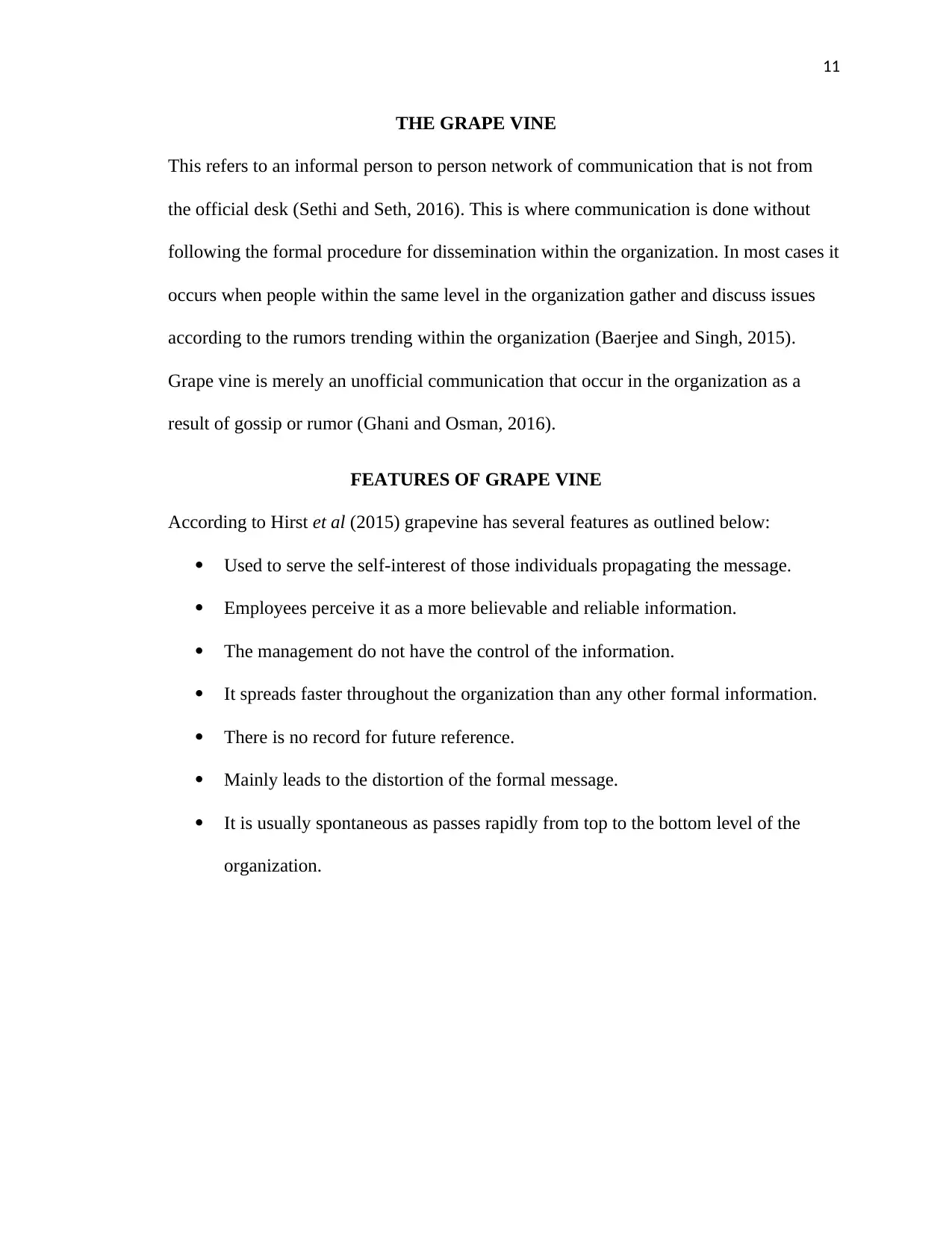
11
THE GRAPE VINE
This refers to an informal person to person network of communication that is not from
the official desk (Sethi and Seth, 2016). This is where communication is done without
following the formal procedure for dissemination within the organization. In most cases it
occurs when people within the same level in the organization gather and discuss issues
according to the rumors trending within the organization (Baerjee and Singh, 2015).
Grape vine is merely an unofficial communication that occur in the organization as a
result of gossip or rumor (Ghani and Osman, 2016).
FEATURES OF GRAPE VINE
According to Hirst et al (2015) grapevine has several features as outlined below:
Used to serve the self-interest of those individuals propagating the message.
Employees perceive it as a more believable and reliable information.
The management do not have the control of the information.
It spreads faster throughout the organization than any other formal information.
There is no record for future reference.
Mainly leads to the distortion of the formal message.
It is usually spontaneous as passes rapidly from top to the bottom level of the
organization.
THE GRAPE VINE
This refers to an informal person to person network of communication that is not from
the official desk (Sethi and Seth, 2016). This is where communication is done without
following the formal procedure for dissemination within the organization. In most cases it
occurs when people within the same level in the organization gather and discuss issues
according to the rumors trending within the organization (Baerjee and Singh, 2015).
Grape vine is merely an unofficial communication that occur in the organization as a
result of gossip or rumor (Ghani and Osman, 2016).
FEATURES OF GRAPE VINE
According to Hirst et al (2015) grapevine has several features as outlined below:
Used to serve the self-interest of those individuals propagating the message.
Employees perceive it as a more believable and reliable information.
The management do not have the control of the information.
It spreads faster throughout the organization than any other formal information.
There is no record for future reference.
Mainly leads to the distortion of the formal message.
It is usually spontaneous as passes rapidly from top to the bottom level of the
organization.
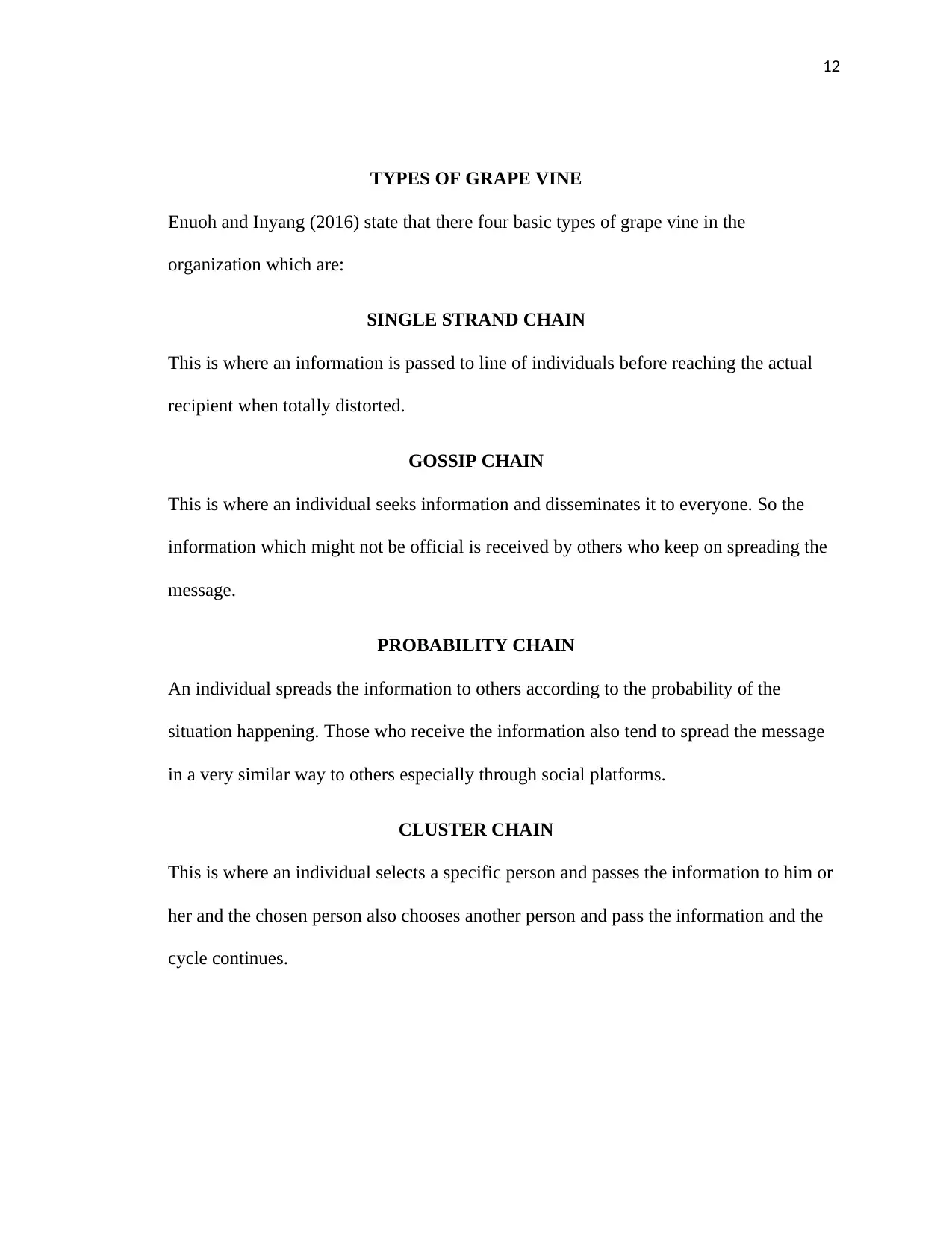
12
TYPES OF GRAPE VINE
Enuoh and Inyang (2016) state that there four basic types of grape vine in the
organization which are:
SINGLE STRAND CHAIN
This is where an information is passed to line of individuals before reaching the actual
recipient when totally distorted.
GOSSIP CHAIN
This is where an individual seeks information and disseminates it to everyone. So the
information which might not be official is received by others who keep on spreading the
message.
PROBABILITY CHAIN
An individual spreads the information to others according to the probability of the
situation happening. Those who receive the information also tend to spread the message
in a very similar way to others especially through social platforms.
CLUSTER CHAIN
This is where an individual selects a specific person and passes the information to him or
her and the chosen person also chooses another person and pass the information and the
cycle continues.
TYPES OF GRAPE VINE
Enuoh and Inyang (2016) state that there four basic types of grape vine in the
organization which are:
SINGLE STRAND CHAIN
This is where an information is passed to line of individuals before reaching the actual
recipient when totally distorted.
GOSSIP CHAIN
This is where an individual seeks information and disseminates it to everyone. So the
information which might not be official is received by others who keep on spreading the
message.
PROBABILITY CHAIN
An individual spreads the information to others according to the probability of the
situation happening. Those who receive the information also tend to spread the message
in a very similar way to others especially through social platforms.
CLUSTER CHAIN
This is where an individual selects a specific person and passes the information to him or
her and the chosen person also chooses another person and pass the information and the
cycle continues.
⊘ This is a preview!⊘
Do you want full access?
Subscribe today to unlock all pages.

Trusted by 1+ million students worldwide
1 out of 39
Related Documents
Your All-in-One AI-Powered Toolkit for Academic Success.
+13062052269
info@desklib.com
Available 24*7 on WhatsApp / Email
![[object Object]](/_next/static/media/star-bottom.7253800d.svg)
Unlock your academic potential
Copyright © 2020–2025 A2Z Services. All Rights Reserved. Developed and managed by ZUCOL.



